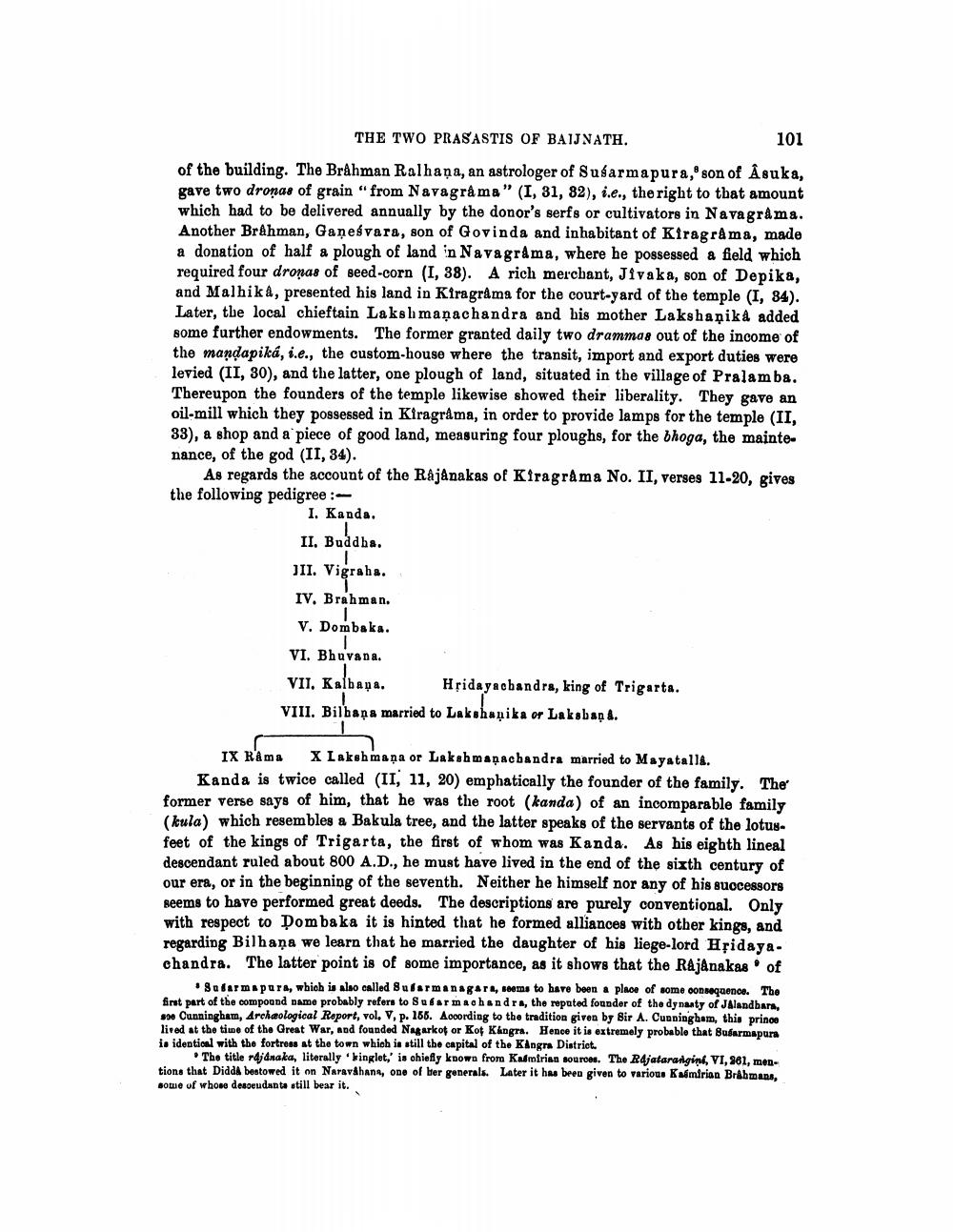________________
THE TWO PRASASTIS OF BAIJNATH.
101
of the building. The Brahman Ralhaņa, an astrologer of Sušarmapura, son of Åsuka, gave two dronas of grain "from Navagrama" (I, 31, 82), i.e., the right to that amount which had to be delivered annually by the donor's serfs or cultivators in Navagrama. Another Brahman, Ganesvara, son of Govinda and inhabitant of Kiragrama, made a donation of half a plough of land in Navagráma, where he possessed a field which required four dronas of seed-corn (I, 38). A rich merchant, Jivaka, son of Depika, and Malhika, presented his land in Kiragráma for the court-yard of the temple (I, 34). Later, the local chieftain Lakshmanachandra and his mother Lakshanike added some further endowments. The former granted daily two drammas out of the income of the mandapika, i.e., the custom-house where the transit, import and export duties were levied (II, 30), and the latter, one plough of land, situated in the village of Pralamba. Thereupon the founders of the temple likewise showed their liberality. They gave an oil-mill which they possessed in Kiragrâma, in order to provide lamps for the temple (II, 33), a shop and a piece of good land, measuring four ploughs, for the bhoga, the maintenance, of the god (II, 34).
As regards the account of the Rajánakas of Kiragrama No. II, verses 11-20, gives the following pedigree:
I. Kanda. II. Buddha. JII. Vigraha. IV. Brahman. V. Dombaka.
VI. Bhuvana.
VII. Kalbana. Hridayacbandrs, king of Trigarta. VIII. Bilbaņa married to Lakshaạika or Laksbaņa.
IX R'Ama X Lakshmana or Lakshmanacbandra married to Mayatalla. Kanda is twice called (II, 11, 20) emphatically the founder of the family. The former verse says of him, that he was the root (kanda) of an incomparable family (kula) which resembles a Bakula tree, and the latter speaks of the servants of the lotusfeet of the kings of Trigarta, the first of whom was Kanda. As his eighth lineal descendant ruled about 800 A.D., he must have lived in the end of the sixth century of our era, or in the beginning of the seventh. Neither he himself nor any of his successors seems to have performed great deeds. The descriptions are purely conventional. Only with respect to Dombaka it is hinted that he formed alliances with other kings, and regarding Bilhana we learn that he married the daughter of his liege-lord Hșidaya. chandra. The latter point is of some importance, as it shows that the Rajánakas of
Safarmapura, which is also called Sufarmanagare, seems to have been a place of some consequence. The first part of the compound name probably refers to Safarmachandra, the reputed founder of the dynasty of JAlandbars, » Cunningham, Archeological Report, vol. V, p. 166. According to the tradition given by Sir A. Cunningham, this prince lived at the time of the Great War, and founded Nagarkot or Kot Kangra. Hence it is extremely probable that Bušarmapura is identical with the fortress at the town which is still the capital of the Kangra District.
The title rdjdnaka, literally 'Singlet,' is chiefly known from Kamirian sources. The Rdjatarailgini, VI, 961, mentions that DiddA bestowed it on Naraváhans, one of ler generals. Later it has been given to various Kaimirian Brahmana, some of whose desceudanta still bear it.




